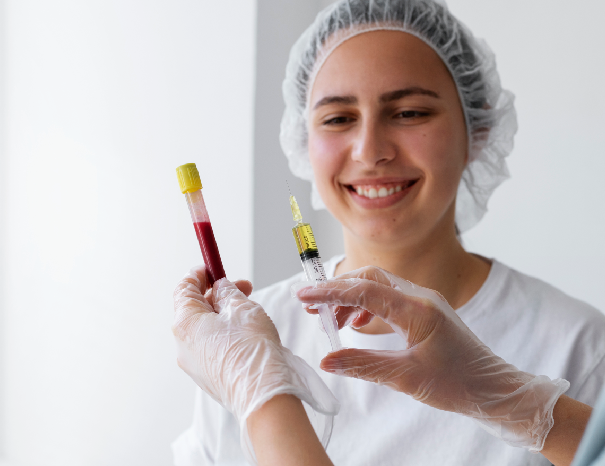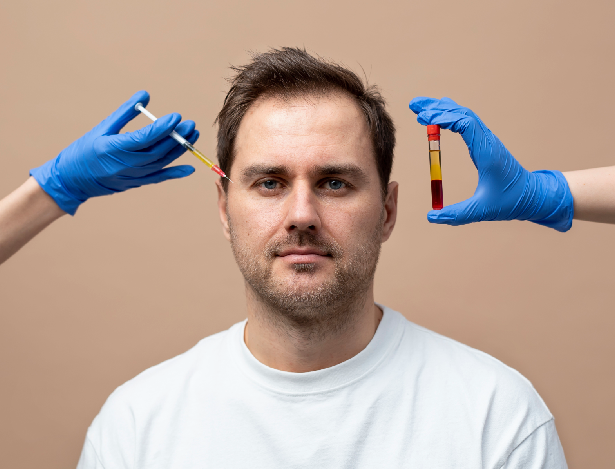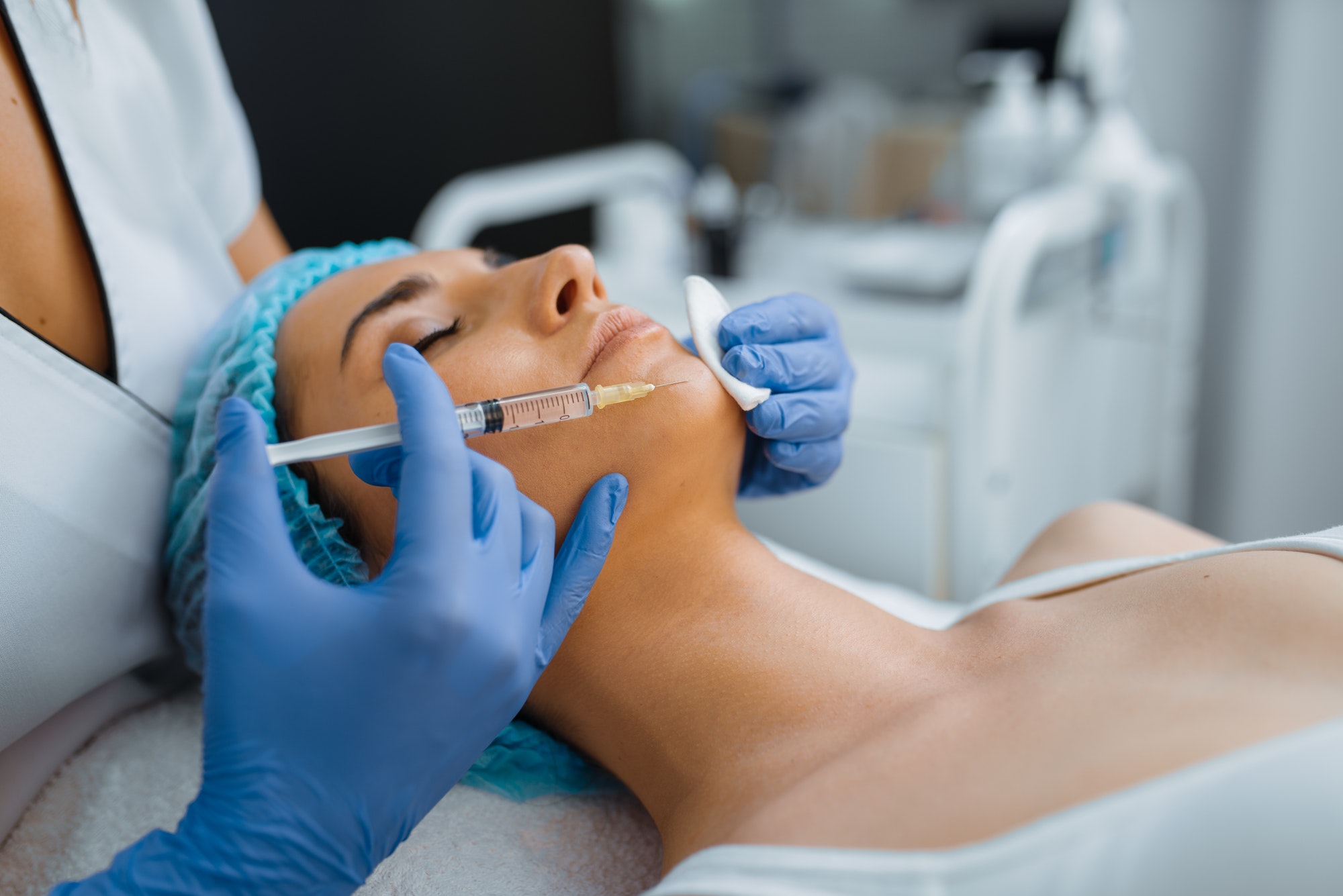PRP Therapy
- Home
- PRP Therapy
PRP Therapy: Harnessing Your Body’s Natural Healing Power
- Primary Sources: Bone marrow, adipose tissue, umbilical cord blood, iPSCs
How PRP Therapy Works
- Blood Draw – A small sample (15-30 mL) is collected from the patient.
- Centrifugation – The blood is spun to separate and concentrate platelets 4-8x above baseline levels.
- Precision Injection – Activated PRP is injected into target areas (joints, scalp, face, etc.) under ultrasound guidance for optimal accuracy.
Biological Healing Timeline
- Inflammatory Phase (0-5 days): Growth factors initiate tissue repair.
- Proliferative Phase (5-21 days): New blood vessels form, and collagen production begins.
- Remodeling Phase (3-6 months): Mature collagen strengthens tissues, restoring function.

Clinical Applications of PRP

PRP Clinical Applications
Dermatology & Aesthetics
- Facial Rejuvenation: Improves skin texture, tightness, and epidermal thickness
- Hand Rejuvenation: Addresses volume loss and aging in underserved areas
- Wound Healing: Accelerates closure of diabetic ulcers (70% success rate in studies)
Hair Restoration
Stimulates follicular regeneration in androgenetic alopecia and thinning hair
Orthopedics & Sports Medicine
Enhances recovery of musculoskeletal injuries (tendons, ligaments, and muscle)
Sexual Wellness
- Improves vascular function in erectile dysfunction
- Reduces stress urinary incontinence symptoms (50% improvement in 8 weeks)
PRP Treatment Outcomes
PRP therapy delivers measurable results across multiple treatment areas with varying timelines. For hair restoration, patients typically notice initial improvements in density and thickness by week 5, with noticeable results becoming apparent within 3-6 months. In aesthetic enhancements, NanoPen® delivery improves skin texture, while lasting volume enhancement becomes visible by week 4. Those seeking orthopedic recovery often experience significant pain reduction and improved mobility after just the first treatment, with optimal outcomes achieved when combined with ESWT or cold laser therapy. For sexual wellness, men report ED improvements within 14 days (especially when combined with vacuum therapy), while women experience FSD relief and can achieve incontinence resolution in just 21 days when following a dedicated Kegel protocol. PRP has also shown exceptional results in wound care, with clinical trials demonstrating 70% efficacy in diabetic foot ulcer management.
PRP Competitive Advantages
Regulatory Status
FDA-cleared for orthopedics with minimal restrictions
Source Material
Autologous blood (low-risk) vs BMAC/adipose/synthetic alternatives
Therapeutic Benefits
- Stimulates native repair mechanisms
- Provides structural volumization
- Enhances tissue hydration
Clinical Applications
Hair | Skin | Joints | Sexual Health | Wound Care | Scar Revision
Practice Benefits
- Low-cost/high percentages of success
- Zero-to-minimal downtime
- High patient satisfaction
Quality Standards
- FDA-cleared for orthopedics
- Minimum 3.5x platelet concentration
- Certified clinician training program

The Science Behind PRP Therapy
PRP harnesses your body’s natural healing mechanisms through concentrated platelets containing over 300 bioactive proteins. When activated, these platelets release influential growth factors, including PDGF (tissue regeneration), VEGF (angiogenesis), and TGF-β (collagen production). The therapeutic process stimulates stem cell recruitment while reducing inflammation, creating an optimal environment for tissue repair. Clinical studies demonstrate PRP’s ability to increase collagen production by 200-300% and accelerate healing timelines by 40-60% compared to natural recovery.
PRP Treatment Process
The PRP procedure takes approximately 60-90 minutes from consultation to completion. Our certified clinicians begin with a small blood draw (15-60ml), followed by centrifugation to concentrate platelets 5- 10x above baseline levels. After activation, the PRP is precisely administered to target areas using ultrasound guidance for optimal placement. Most patients experience minimal discomfort and can resume normal activities within 24-48 hours, with no scarring or significant downtime required.
Ideal Candidates for PRP
PRP therapy benefits adults of all ages seeking natural healing solutions. Ideal candidates include those with early-stage hair loss, mild-to-moderate joint degeneration, or skin laxity concerns. Patients with chronic wounds or sexual dysfunction may also benefit. We carefully evaluate medical history, as PRP is not recommended for individuals with blood disorders, active infections, or certain autoimmune conditions. A consultation with our specialists will determine your eligibility and expected outcomes.
Why Choose Our PRP Therapy?
Our clinic delivers superior PRP results through FDA-cleared systems, consistently achieving optimal 3- 5x platelet concentration. Unlike generic approaches, we customize treatments based on diagnostic imaging and individual healing factors. Our physicians have completed advanced regenerative medicine training and follow evidence-based protocols published in peer-reviewed journals. Combined with complementary technologies like microneedling and shockwave therapy, we achieve outcomes that surpass standard PRP treatments.
Revitalife
The Role of PRP in Medicine
PRP Therapy: A revolutionary advancement bridging regenerative medicine and aesthetic enhancement. This autologous treatment delivers:
- Orthopedic Solutions: Non-surgical repair of soft tissue injuries with lasting pain relief
- Aesthetic Transformations: Natural facial rejuvenation, hair restoration, and sexual wellness improvements
By harnessing the body’s innate healing potential, PRP establishes itself as the gold-standard biological treatment across medical specialties.

Choosing the Right PRP System
PRP System Selection Matters
Choosing the right PRP system is critical for optimal treatment outcomes. FDA-cleared equipment is essential to ensure consistent platelet concentration of 3- 5x baseline levels, while validated protocols based on peer-reviewed studies guarantee clinical efficacy. Perhaps most importantly, clinician expertise through specialized training maximizes therapeutic results. When these quality systems are combined with proper injection technique, patients receive superior biological outcomes that meet the highest standards of regenerative medicine.

